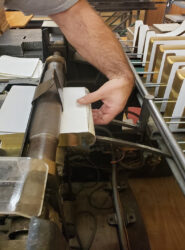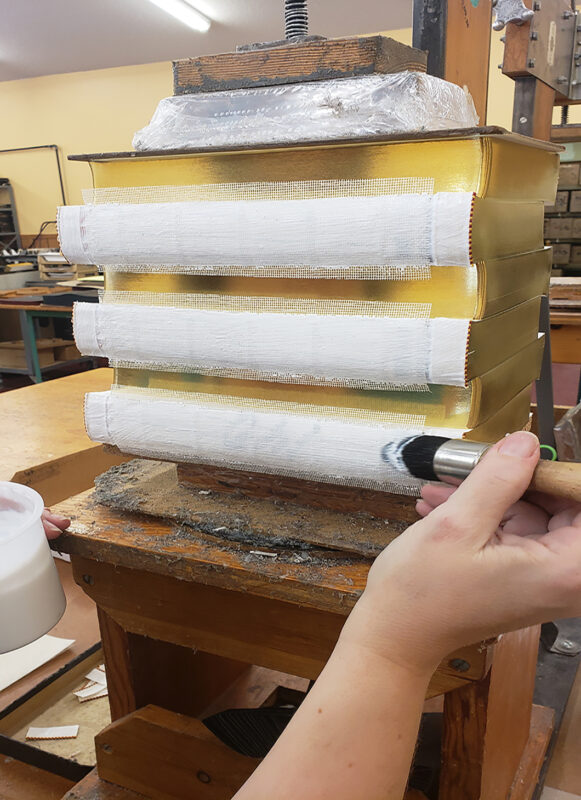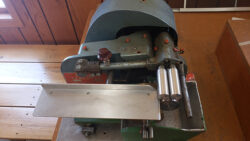How our Bibles are made, part 3
Welcome back to the blog!
Over the last few weeks we have been taking a “tour” through how our Bibles are made with the addition of some random facts about the process. In today’s post, I would like to finish our “tour” by walking you though the final steps of the binding operation.
In the first week, we covered the designing process through the “smashing” machine. The following week we took the time to walk you though the beginning stages in the cosmetic processes of the Bible binding process. We trim the Bibles before taking them on to be clamped into a rolling clamp which will hold them in the correct pressurized position for the sanding process. During the sanding process great attention to detail is taken in making the edges of the Bible pages as smooth as glass. After the sanding process is the gilding machine where the gold foil is adhered to the edges with multiple heated rollers. The opening process is where we take the time to fan the pages which have been stuck together because of the adhesive for the art gilding. When we complete this step our customers will be able to fan open there Bible the first time they use it instead of having the edges randomly clumped together from the foil adhesive. The last step we covered last week was the inserting of the ribbons for the Bible and how they have been cut to the measurements needed for each size of Bible we produce.
 Let’s continue on to the process of putting the round into the spines of the Bibles. The glue which has been applied at the glue off process (one of the earlier steps) is heated up on a special heater which allows the Bibles to be set on their spines. Once the glue on the spines of the Bibles are heated enough to be malleable, the Bible is set down on the back of the Bible with the spine facing a set of rollers. The rollers on this machine have been specifically designed in their operation. The rollers will move in opposite directions so as to pull the spine into a rounded fashion. While the glue on the spines are still warm and after the round has been made, the Bibles are set into a cooling rack which will allow the spines to harden into their rounded state.
Let’s continue on to the process of putting the round into the spines of the Bibles. The glue which has been applied at the glue off process (one of the earlier steps) is heated up on a special heater which allows the Bibles to be set on their spines. Once the glue on the spines of the Bibles are heated enough to be malleable, the Bible is set down on the back of the Bible with the spine facing a set of rollers. The rollers on this machine have been specifically designed in their operation. The rollers will move in opposite directions so as to pull the spine into a rounded fashion. While the glue on the spines are still warm and after the round has been made, the Bibles are set into a cooling rack which will allow the spines to harden into their rounded state.
After being pulled from the cooling racks, the Bibles are stacked in stacks of 6 Bibles (on average) to be taken through the head banding process. At the head banding station we take the time to add all of the reinforcement to the spine. We glue the ribbons down at the top of the Bible spine along with the head band and move on to gluing on the foot band after that. Just as you would put the trim pieces around a window which are not necessary to the structure of a building, we take the  time to add the head and foot bands on the spines of the Bibles. Next is the application of the mesh which will reinforce the sewing of the spine. The last step at this station is gluing on the “tube”, which is a pre-folded piece of special material which allows the Bible to lay flat after production. This station and all of its many steps is one of the key factors which sets us apart in the industry and holds our product to above industry standards.
time to add the head and foot bands on the spines of the Bibles. Next is the application of the mesh which will reinforce the sewing of the spine. The last step at this station is gluing on the “tube”, which is a pre-folded piece of special material which allows the Bible to lay flat after production. This station and all of its many steps is one of the key factors which sets us apart in the industry and holds our product to above industry standards.
From the head banding station we move onto the preparation of the covers for the Bibles. There is a special jig which allows us to open the spine width of the cover to fit on the Bible properly. The edge of the flaps of which are opened here become the hinge for the covers. The casing process is where we attach the cover to the Bible. Glue as applied by hand to the inner spine and flaps of the Bible before is it adhered to the tube on the Bible and the flaps to the outer pages of the Bible.
 If you will remember, one of the first steps of the binding process entailed the inserting of the endleaf pages. The last step of the actual binding process is to attach those pages through a what we call “tipping”. We take out the piece, make sure it is going to match up with the corners of the Bible, and then run it through a machine to apply a thin layer of glue which will reinforce the flaps of the Bible.
If you will remember, one of the first steps of the binding process entailed the inserting of the endleaf pages. The last step of the actual binding process is to attach those pages through a what we call “tipping”. We take out the piece, make sure it is going to match up with the corners of the Bible, and then run it through a machine to apply a thin layer of glue which will reinforce the flaps of the Bible.
Once the Bibles have finished the binding process, they are inspected for flaws (to the best of our human possibility). We take the time to do a re inspection of the cover, the foil gilding, the head banding, the case in process, the tipping, etc. As a final step, the Bibles are individually banded and wrapped before being brought into the distribution center.
There truly is a lot that goes into the binding process of a Bible from Church Bible Publishers. This is a craft to us and we take our work seriously in providing top quality Bibles to our customers. I hope that you have been able to understand more of what we do and all that goes into bringing you a Bible from CBP.

